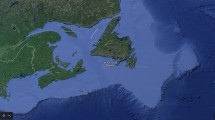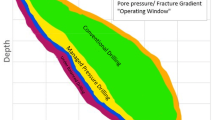Abstract
A critical component of Milwaukee’s $ 2.8 billion Water Pollution Abatement Program is a 31.2-km inline storage system comprising three Deep Tunnel sections that were bored between 1984 and 1993 at a depth of 80–100 m within Silurian-aged Niagara dolostone. Construction of these Deep Tunnels proved more difficult and expensive than estimated because the karstic nature of the dolostone, particularly its hydrology, had not been fully appreciated. Rock collapse, subsidence and groundwater intrusion necessitated remedial grouting and lining of about 45% of the tunnels, costing some $ 50 million above estimates and delaying completion by 9 months. Tunnel performance since completion continues to be controversial.

Similar content being viewed by others
References
Baier DR, Lasca NP (1988) Chicago’s Mainstream Deep Tunnel Project. In: Proc Int Symp Tunneling for Water Resources and Power Projects, New Delhi. Balkema, Rotterdam, pp 159–163
Bradbury KR, Muldoon MA (1992) Hydrogeology and groundwater monitoring of fractured dolomite in the Upper Door County Priority Watershed, Door County, Wisconsin. Wisconsin Geol Nat Hist Surv Open-File Rep 92-2
Bradbury KR, Muldoon MA (1994) Effects of fracture density and anisotropy on wellhead protection area delineation in fractured-rock aquifers. Appl Hydrogeol 2(3):17–23
Burke J (2002) Deja-vu completion for Milwaukee Deep Sewer. World Tunnel 15(10):471–474
Cherkauer DS (1996) Impact of tunnel dewatering on surface water bodies in Milwaukee County: determination of hydrogeologic controls and the efficiency of monitoring arrays. UW System Groundwater Research Program Groundwater Res Rep WRC GRR 9603
Cherkauer DS, Zvibleman B (1981) Hydraulic connection between Lake Michigan and a shallow ground-water aquifer. Ground Water 19(4):376–381
Cikanek EM, Goyal BB (1987) Experiences from large cavern excavation for TARP. In: Saari KHO (ed) Proc Int Symp Large Rock Caverns, Helsinki. Pergamon Press, New York, vol 1, pp 35–46
Dalton FE, LaRusso RS (1979a) Chicago’s TARP solves problems in big way. Part 1. Water Wastes Eng 16(1):18–22, 43
Dalton FE, LaRusso RS (1979b) Chicago’s TARP solves problems in big way. Part 2. Water Wastes Eng 16(3):36–38, 43–44
ENR (2002) Milwaukee audit cites system operation for sewer overflows. http://www.enr.com/news/environment/archives/020902.asp Accessed November 2002
Ford DC, Williams PW (1989) Karst geomorphology and hydrology. Unwin Hyman, London
Jansen J, Taylor RW (1989) Locating bedrock fractures with surface geophysics. Geol Soc Am Abstr Programs 21(4)
Klug CR (1977) The Upper Silurian of Wisconsin. In: Nelson KG (ed) Geology of Southeastern Wisconsin. Guideb 41st Tri-State Field Conf, Milwaukee, WI. University of Wisconsin-Milwaukee, pp A35–A39
Mikulic DG (1977) A preliminary revision of the Silurian stratigraphy of southeastern Wisconsin. In: Nelson KG (ed) Geology of Southeastern Wisconsin. Guideb 41st Tri-State Field Conf, Milwaukee, WI. University of Wisconsin-Milwaukee, pp A6–A34
Milwaukee Journal (1988a) Contractors will try to plug leaks in tunnel with cement. 19 April:1B
Milwaukee Journal (1988b) Tunneling through the unknown. 13 November:1B
Milwaukee Journal (1991) Water problem raises tunnel cost. 3 January:1B
Milwaukee Journal (1992) Deep tunnel dispute results in suit. 3 May:1B
Milwaukee Journal Sentinel (2001a) Overflowing with Problems. 1 July 2001:1A
Milwaukee Journal Sentinel (2001b) Deal calls for major upgrade of sewers. 8 September 2001:1A
Milwaukee Journal Sentinel (2003) DNR to look into extent of sewage dumping. 4 July:1B
MMSD (2000) Deep Tunnel first inspection shows no obstructions. Metropolitan Milwaukee Sewerage District http://www.mmsd.com/deeptunnel/tunnelinspect.html Accessed March 2000
MMSD (2003) Deep Tunnel Fact Sheet. Metropolitan Milwaukee Sewerage District http://www.mmsd.com/tunnelfactsheet.html Accessed July 2003
Muldoon MA, Simo JA, Bradbury KR (2001) Correlation of high-permeability zones with stratigraphy in a fractured-dolomite aquifer, Door County, Wisconsin. Hydrogeol J 9(6):570–583
Ostrom ME (1967) Paleozoic stratigraphic nomenclature for Wisconsin. Wisconsin Geol Nat Hist Surv Inf Circ 8
Rajaram V (1988) Environmental impacts of tunneling in urban areas. In: Proc Int Symp Tunneling for Water Resources and Power Projects, New Delhi. Balkema, Rotterdam, pp 440–446
Rovey CW (1990) Stratigraphy and sedimentology of Silurian and Devonian carbonates, Eastern Wisconsin, with implications for ground-water discharge into Lake Michigan. PhD Dissertation, University of Wisconsin-Milwaukee
Rovey CW, Cherkauer DS (1994a) Relation between hydraulic conductivity and texture in carbonate aquifer: observations. Ground Water 32(1):53–62
Rovey CW, Cherkauer DS (1994b) Relation between hydraulic conductivity and texture in carbonate aquifer: regional continuity. Ground Water 32(2):227–238
Rovey CW, Cherkauer DS (1995) Scale dependency of hydraulic conductivity measurements. Ground Water 33(5):769–780
Sherrill MG (1978) Geology and ground water in Door County, Wisconsin, with emphasis on contamination potential in the Silurian dolomite. US Geol Surv Water Supply Pap 2047
Tarricone P (1990) Tales from Milwaukee’s underground. Civil Eng 60(1):50–53
Weirsma JH, Stieglitz RD, Cecil DL, Metzler GM (1984) Characterization of the shallow groundwater system in an area of thin soils and sinkholes (Door Co., WI). In: Beck BF (ed) Sinkholes: their geology, engineering and environmental impact. Balkema, Rotterdam, pp 305–310
White WB (1988) Geomorphology and hydrology of karst terrains. Oxford University Press
Wisconsin State Journal (2001) Sewage tunnels polluting water. 2 July 2001:3C
Worthington SR (2002) Test methods for characterizing contaminant transport in a glaciated carbonate aquifer. Environ Geol 42(5):546–551
Worthington SR (2003) Identification of rapid groundwater flow to the contaminated municipal wells in the karst aquifer at Walkerton, Ontario. Geo2 29(3/4):32–34
Acknowledgements
I am grateful to Patti Day (American Geographical Society Library at UWM) and Sean Chenoweth (UWM Geography Department) for their assistance with this topic. MMSD kindly provided assorted Deep Tunnel and WPAP information. The UWM Cartography and GIS Center produced the figure.
Author information
Authors and Affiliations
Corresponding author
Rights and permissions
About this article
Cite this article
Day, M.J. Karstic problems in the construction of Milwaukee’s Deep Tunnels. Env Geol 45, 859–863 (2004). https://doi.org/10.1007/s00254-003-0945-4
Received:
Accepted:
Published:
Issue Date:
DOI: https://doi.org/10.1007/s00254-003-0945-4




